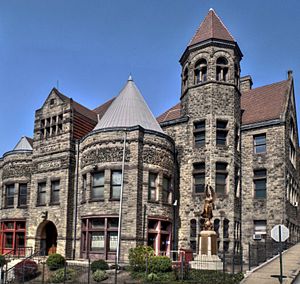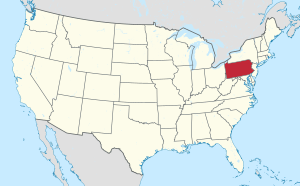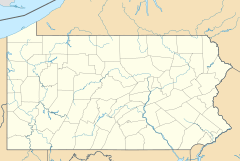Braddock, Pennsylvania facts for kids
Quick facts for kids
Braddock, Pennsylvania
|
|
|---|---|
|
Borough
|
|

Braddock Carnegie Library, May 2010
|
|

Location in Allegheny County and the U.S. state of Pennsylvania
|
|

Location of Pennsylvania in the United States
|
|
| Country | United States |
| State | Pennsylvania |
| County | Allegheny |
| Settled | 1742 |
| Incorporated | June 8, 1867 |
| Government | |
| • Type | Borough Council |
| Area | |
| • Total | 0.66 sq mi (1.71 km2) |
| • Land | 0.56 sq mi (1.46 km2) |
| • Water | 0.10 sq mi (0.25 km2) |
| Elevation | 764 ft (233 m) |
| Population
(2020)
|
|
| • Total | 1,721 |
| • Density | 3,056.84/sq mi (1,179.85/km2) |
| Time zone | UTC-5 (EST) |
| • Summer (DST) | UTC-4 (EDT) |
| ZIP Code |
15104
|
| Area code(s) | 412 |
| FIPS code | 42-07992 |
| School District | Woodland Hills |
Braddock is a small town, called a borough, located near Pittsburgh in Allegheny County, Pennsylvania, United States. It sits along the Monongahela River. In 2020, about 1,721 people lived there. This is a big change from 1920, when over 20,000 people lived in Braddock.
Contents
History of Braddock
Early Days and a Famous Battle
Braddock is named after General Edward Braddock. In 1755, he led British troops in a battle here against the French. This event, known as the Battle of the Monongahela, was a key moment in the French and Indian War. General Braddock was badly hurt in this battle.
Before the Europeans arrived, the Lenape people lived in this area. Their leader was Queen Alliquippa. In 1742, John Fraser started the first lasting English settlement west of the Allegheny Mountains here. Later, George Washington visited the area in 1753-1754.
The Rise of Industry
Braddock's first factory, which made barrels, opened in 1850. The town officially became a borough on June 8, 1867. The town's industrial story truly began in 1873. That's when Andrew Carnegie built the Edgar Thomson Steel Works nearby. This was one of the first American steel mills to use the Bessemer process, a new way to make steel. Today, this steel mill is still working as part of the United States Steel Corporation.
Carnegie Library: A Special Place
Braddock is also home to the very first public library built by Andrew Carnegie in the United States. It opened on March 30, 1889. This library was special because it had a tunnel entrance for steelworkers. They could use a bathhouse in the basement to clean up before going into the library. The library also had billiard tables, a swimming pool, a basketball court, and a music hall.
In 1978, people saved the building from being torn down. It is still used as a public library today. The old bathhouse is now a pottery studio. The music hall is being fixed up.
Changes Over Time
In the early 1900s, many immigrants from places like Croatia, Slovenia, and Hungary came to live in Braddock.
However, in the 1970s and 1980s, the steel industry in the United States faced big problems. This caused Braddock to lose many jobs and people. The town's population dropped by 90% from its highest point in the 1920s.
Since 2005, former mayor John Fetterman has worked to bring new life to Braddock. He has tried to attract artists and creative people to the area. He also started a group called Braddock Redux to help the town. Many news outlets have featured his efforts to help Braddock.
Filmmaker Tony Buba, who lives in Braddock, has made many movies about the town's industrial decline. In 2010, a film called Ready to Work: Portraits of Braddock showed how local people were trying to help their town.
Geography
Braddock is located at 40°24′13″N 79°52′7″W / 40.40361°N 79.86861°W.
The town covers about 0.6 square miles (1.7 square kilometers). Most of this area is land, with a small part being water. The average height of Braddock above sea level is about 764 feet (233 meters).
Population Changes
| Historical population | |||
|---|---|---|---|
| Census | Pop. | %± | |
| 1870 | 1,290 | — | |
| 1880 | 3,310 | 156.6% | |
| 1890 | 8,561 | 158.6% | |
| 1900 | 15,654 | 82.9% | |
| 1910 | 19,357 | 23.7% | |
| 1920 | 20,879 | 7.9% | |
| 1930 | 19,329 | −7.4% | |
| 1940 | 18,326 | −5.2% | |
| 1950 | 16,488 | −10.0% | |
| 1960 | 12,337 | −25.2% | |
| 1970 | 8,795 | −28.7% | |
| 1980 | 5,634 | −35.9% | |
| 1990 | 4,682 | −16.9% | |
| 2000 | 2,912 | −37.8% | |
| 2010 | 2,159 | −25.9% | |
| 2020 | 1,721 | −20.3% | |
| Sources: | |||
Braddock's population grew a lot during the steel industry boom. It reached its highest point in 1920 with over 20,000 people. Since then, the population has steadily decreased. By 2020, it was 1,721.
In 2020, about 34.2% of people in Braddock had jobs. The average household income was $23,050. About 10.7% of the population had a college degree or higher.
Education
Students in Braddock attend schools in the Woodland Hills School District.
Notable People
Many interesting people have come from Braddock:
- Thomas Bell – a writer who set his novel Out of This Furnace in Braddock.
- Tony Buba – a filmmaker who makes movies about the town.
- John Clayton – a sportswriter and NFL analyst.
- John Fetterman – former mayor of Braddock and now a U.S. Senator from Pennsylvania.
- Gisele Barreto Fetterman – former Second Lady of Pennsylvania.
- LaToya Ruby Frazier – an artist who won a MacArthur Fellowship.
- Captain Bill Jones – the first superintendent of the Edgar Thomson Steel Works under Andrew Carnegie.
- Billy Knight – a former NBA player and executive.
- George Peppard – an actor who worked in Braddock early in his career.
- Lauren Tewes – an actress known for her role on The Love Boat.
See also
 In Spanish: Braddock (Pensilvania) para niños
In Spanish: Braddock (Pensilvania) para niños



